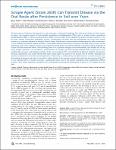Scrapie Agent (Strain 263K) Can Transmit Disease via the Oral Route after Persistence in Soil over Years
Seidel, Bjoern
Thomzig, Achim
Buschmann, Anne
Groschup, Martin H.
Peters, Rainer
Beekes, Michael
Terytze, Konstantin
The persistence of infectious biomolecules in soil constitutes a substantial challenge. This holds particularly true with respect to prions, the causative agents of transmissible spongiform encephalopathies (TSEs) such as scrapie, bovine spongiform encephalopathy (BSE), or chronic wasting disease (CWD). Various studies have indicated that prions are able to persist in soil for years without losing their pathogenic activity. Dissemination of prions into the environment can occur from several sources, e.g., infectious placenta or amniotic fluid of sheep. Furthermore, environmental contamination by saliva, excrements or non-sterilized agricultural organic fertilizer is conceivable. Natural transmission of scrapie in the field seems to occur via the alimentary tract in the majority of cases, and scrapie-free sheep flocks can become infected on pastures where outbreaks of scrapie had been observed before. These findings point to a sustained contagion in the environment, and notably the soil. By using outdoor lysimeters, we simulated a contamination of standard soil with hamster-adapted 263K scrapie prions, and analyzed the presence and biological activity of the soil-associated PrPSc and infectivity by Western blotting and hamster bioassay, respectively. Our results showed that 263K scrapie agent can persist in soil at least over 29 months. Strikingly, not only the contaminated soil itself retained high levels of infectivity, as evidenced by oral administration to Syrian hamsters, but also feeding of aqueous soil extracts was able to induce disease in the reporter animals. We could also demonstrate that PrPSc in soil, extracted after 21 months, provides a catalytically active seed in the protein misfolding cyclic amplification (PMCA) reaction. PMCA opens therefore a perspective for considerably improving the detectability of prions in soil samples from the field.
Dateien zu dieser Publikation
Keine Lizenzangabe

